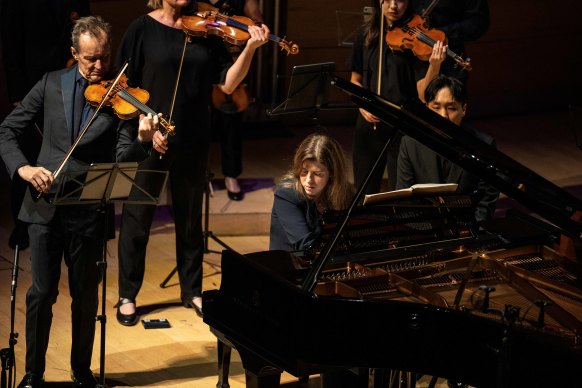Save articles for later
Add articles to your saved list and come back to them any time.
Chopin and the Mendelssohns
Australian Chamber Orchestra
Opera House Concert Hall, November 12
Reviewed by PETER McCALLUM
★★★★
Early genius and premature death marked the three 19th century Romantic composers of the Australian Chamber Orchestra’s final concert for the year.
All had been astonishing prodigies in their teens, but none made it to the middle of the century in which they had been born. Fanny Mendelssohn, the oldest, died first of a stroke aged 41, her younger brother Felix suffering the same fate within six months.
Frederick Chopin, the youngest of the trio was taken by the illness that had consumed his last years just under two years later. To begin the concert, pianist Polina Leschenko and ACO Director Richard Tognetti played the Concerto for Violin and Piano in D minor, an astonishingly precocious work by the 14-year-old Felix, who also performed the brilliantly virtuosic piano part, partnering with his violin teacher Eduard Ritz, at its first performance.
Pianist Polina Leschenko and ACO Director Richard Tognetti opened with Felix Mendelssohn’s Concerto for Violin and Piano in D minor.Credit: Nic Walker
Although clearly written in the classical mould of Beethoven (still alive at the time and a profound inspiration for the young prodigy), the duo concerto has some hallmarks of the new generation. It exaggerates the difference in expression and tempo between the spiky, driven first idea of the first movement, with nimble impetuous passagework from the soloists, and the expressive second theme.
Leschenko’s natural manner at the piano nurtures its softer tones and, in the second movement, after the orchestra strings had announced an adagio theme of classic simplicity, she established a dreamy sound with moments of stillness towards the close. In the last movement, Leschenko and Tognetti sprang forward as though releasing the energy pent-up in the first.
Chopin’s Piano Concerto No 2 in F minor (actually the first written) was also the work of a teenager, and Leschenko created piano filigree with a tone of clarity and quiet finish. In the second she created arabesques around the central idea with fanciful freedom, while the finale swept forward with graceful facility.
The ACO, led by Tognetti, accompanied discreetly in an arrangement of Chopin’s original for string orchestra by Ilan Rogoff. Commenting on her String Quartet in E flat, Fanny Mendelssohn, in a regrettable moment of culturally influenced self-doubt about her abilities as a female composer, expressed the view she was better suited to smaller forms and lacked the ability to develop ideas in a sustained way.
After hearing the ACO articulate the subtle whimsy and restraint of the quiet adagio that makes up the first movement, one could beg to disagree. The things she had doubts about were, in fact, her artistic strengths. After a vigorous scurrying scherzo, she again finds her distinctive voice in the slow movement, while the last movement leapt with touching high spirit underlaid by contrapuntal skill. The Chopin concerto is a frequent and welcome guest on concert programs and one could wish the same for these neglected works by the Mendelssohns.
The Booklist is a weekly newsletter for book lovers from books editor Jason Steger. Get it delivered every Friday.
Most Viewed in Culture
From our partners
Source: Read Full Article
